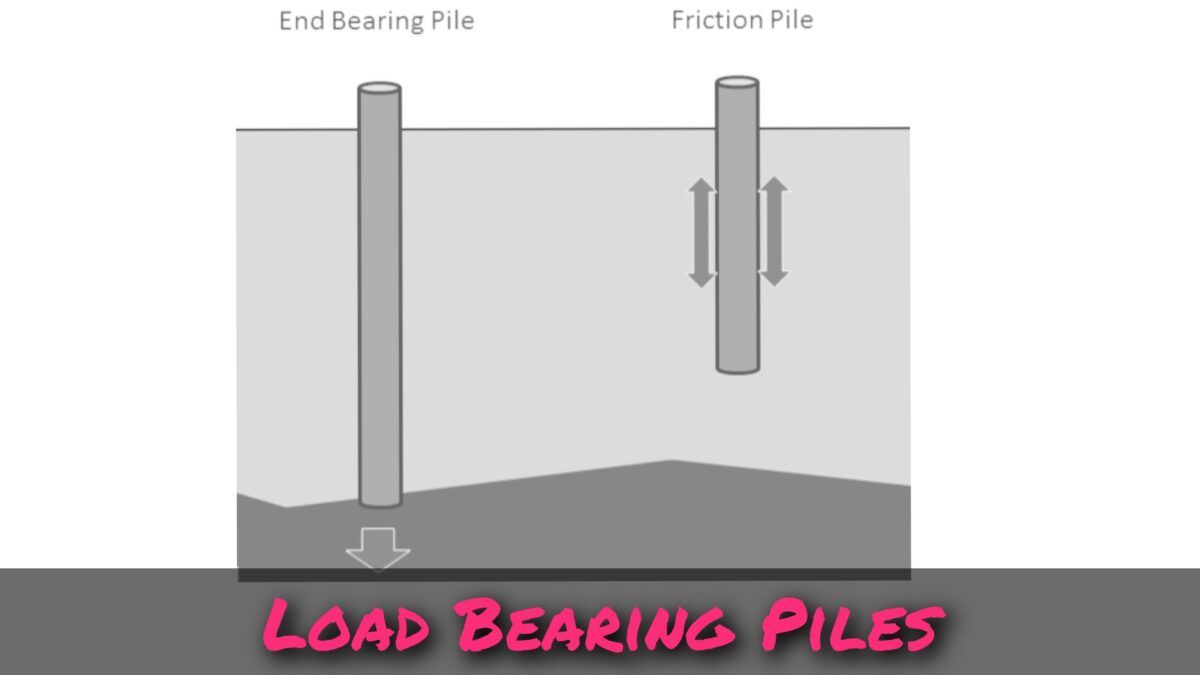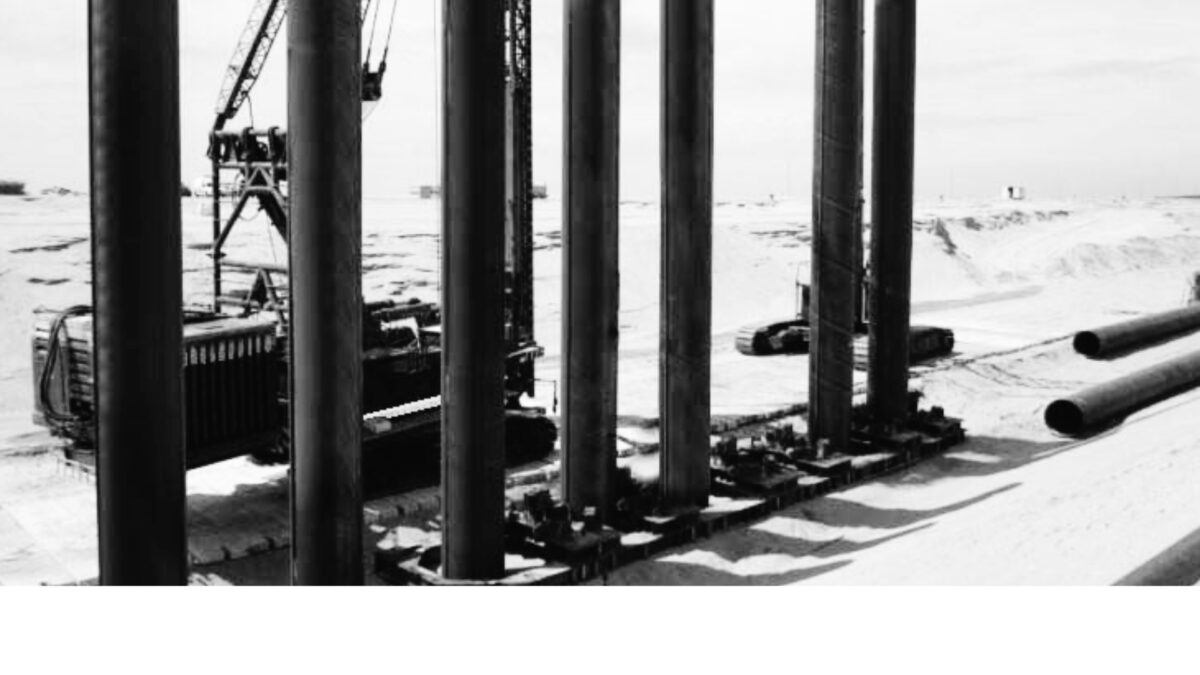In this article, I describe load bearing piles and types of load bearing piles.
Table of Contents
What Are Load Bearing Piles?
Load bearing piles are a type of deep foundation system installed to support vertical loads by transferring the weight of a structure to the soil or rock below.

They are commonly used when the surface soil is weak or unable to support the weight of a new construction, or when the soil conditions are unfavorable for direct foundation support.
Steel pipes are frequently used to create load-bearing piles due to their strength and durability.

These piles are driven into the ground using techniques such as pile driving, which involves using a large hammer to forcefully insert the pile into the soil until it reaches a competent layer capable of supporting the load.
Load-bearing piles are necessary in two main situations. The first is when there is a weak layer of soil near the surface of a construction site. In this case, the shallow soil is unable to bear the weight of the structure, necessitating the use of load-bearing piles to transfer the load to deeper, more competent soil or rock layers.
The second situation where load-bearing piles are required is when the surface soil conditions are unsuitable for supporting the structure, regardless of the soil’s strength. This could be due to factors such as expansive clay, loose sand, or other unstable soil types. Load-bearing piles provide a stable foundation by bypassing the inadequate surface soil and transferring the load to stronger layers.
By installing load-bearing piles, the weight of the structure is effectively distributed and transmitted to the deeper soil or rock, reducing the risk of settlement or failure. Load-bearing piles play a critical role in ensuring the stability and safety of various construction projects, including high-rise buildings, bridges, and infrastructure developments.
Types Of Load Bearing Piles
Normally, 2 types of load bearing poles are used in construction. They are;
- End Bearing Piles
- Friction Piles
We will discuss these 2 types of load bearing piles in detail.
1. End Bearing Piles
The end bearing piles are installed by driving them into the ground until the lower end tip of the pile rests within the intermediate layer situated between weaker and stronger soil layers.
These piles function as columns, effectively transferring the load from the superstructure onto the underlying soil.
Calculating the bearing capacity of an end-bearing pile involves a straightforward process of multiplying the area of the pile’s bottom tip by the bearing capacity at the specific depth where it is embedded in the soil.
By incorporating an appropriate factor of safety, the diameter of the pile can be determined.
2. Friction Pile
A friction pile is a type of load-bearing pile that relies on the frictional interaction between the surface of the pile and the surrounding soil layer to transfer the load to the soil.
The friction force in a friction pile can be generated along the entire length of the pile or only over a specific length, depending on the characteristics of the soil strata.
Unlike end-bearing piles, which primarily transfer loads through the pile’s base, friction piles utilize the entire surface area of the pile to transmit the loads from the superstructure to the underlying soil.
To determine the capacity of friction piles, the surface area of the pile is multiplied by the friction force developed per unit area. It is essential to incorporate an appropriate factor of safety during the design of friction piles to ensure their reliability.
Uses Of Load Bearing Piles
1. High-rise Buildings:
Load-bearing piles are commonly used in the construction of tall buildings, especially in urban areas where the soil may be weak or subject to settlement.
Piles are driven into the ground to reach competent soil or rock layers, providing a solid foundation to support the weight of the structure.
2. Bridges and Overpasses:
Piles are used extensively in the construction of bridges and overpasses to transfer the weight of the structure and traffic loads to the underlying ground.
Piles provide stability and prevent settlement, ensuring the integrity of the bridge.
2. Wharves and Ports:
Load-bearing piles are used in the construction of wharves, piers, and other waterfront structures.
These piles support the weight of the structure and provide resistance against lateral forces such as waves and currents.
Piles can be made of various materials, including steel, concrete, or timber, depending on the specific requirements of the project.
3. Retaining Walls:
Piles are often used in the construction of retaining walls to support vertical or near-vertical soil or rock masses.
They are driven into the ground at regular intervals and provide resistance against the lateral pressure exerted by the retained soil.
This helps prevent soil movement and potential collapse of the wall.
4. Offshore Structures:
Load-bearing piles are employed in the construction of offshore platforms, such as oil rigs, wind farms, and marine terminals.
These piles are driven into the seabed to anchor the structures and withstand the forces of waves, currents, and wind.
5. Deep Foundations:
In areas with weak or unstable soil conditions, load-bearing piles are used as deep foundations. They can reach deep into the ground, bypassing weak soil layers, and transfer the load to more competent strata.
This is common in areas with soft or expansive soils, where shallow foundations would be inadequate.
6. Industrial Structures:
Load-bearing piles are utilized in the construction of various industrial structures, such as power plants, factories, and storage facilities.
These structures often require strong and stable foundations to support heavy machinery, equipment, and storage loads.
7. Infrastructure Projects:
Load-bearing piles are essential in infrastructure projects like highways, tunnels, and railways. Piles provide stability to structures, prevent settlement, and ensure the safe transportation of people and goods.
Faqs
Load bearing piles are strong supports that help buildings and structures stay stable. There are different types of piles, like concrete piles, steel piles, and wooden piles.
Load bearing piles are made by either pushing them into the ground with special equipment or by digging a hole and filling it with strong concrete.
End bearing piles are piles that rest on a very hard and strong layer of soil or rock deep underground. They hold up the building by sitting on this strong layer and taking the weight of the structure.
Friction piles don’t need a hard layer of soil or rock to rest on. They stay strong because the soil around them sticks to them, like when you rub your hands together. The friction between the pile and the soil helps support the building.
Engineers think about a few things before deciding which pile to use. They consider how the soil is, how deep the strong layer is, how heavy the building is, and how much it will cost. They do tests and investigations to help them choose the right pile for the job.
